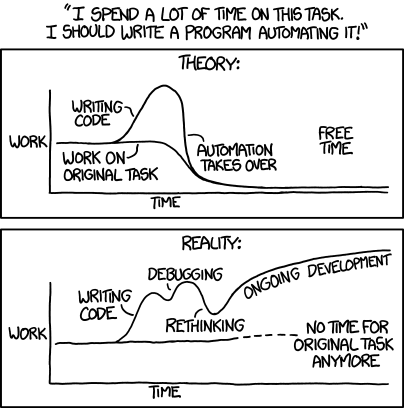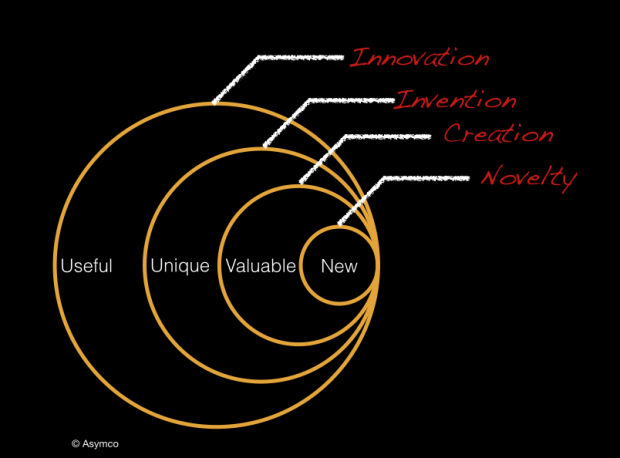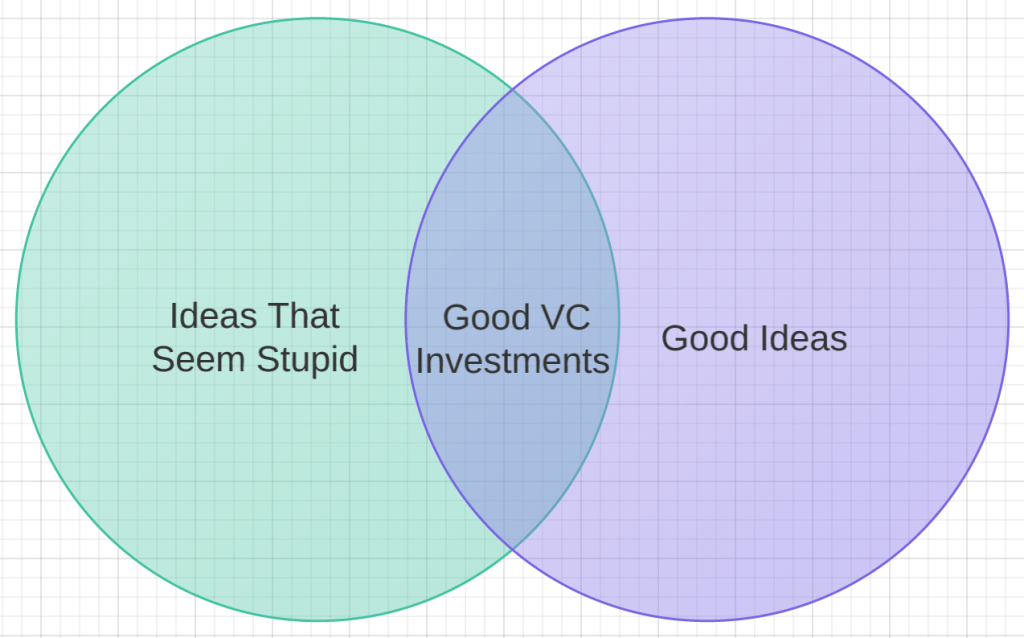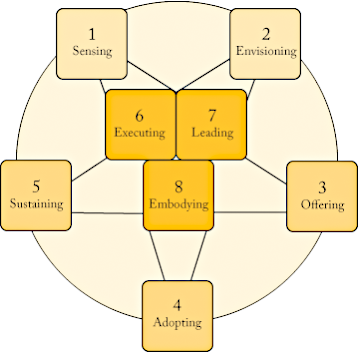Innovation is about finding a better way of doing something. Like many of the new development buzzwords (which many of them are over-used on many business documents), the concept of innovation originates from the world of business. It refers to the generation of new products through the process of creative entrepreneurship, putting it into production, and diffusing it more widely through increased sales. Innovation can be viewed as t he application of better solutions that meet new requirements, in-articulated needs, or existing market needs. This is accomplished through more effective products, processes, services, technologies, or ideas that are readily available to markets, governments and society. The term innovation can be defined as something original and, as a consequence, new, that “breaks into” the market or society.
Innoveracy: Misunderstanding Innovation article points out that there is a form of ignorance which seems to be universal: the inability to understand the concept and role of innovation. The way this is exhibited is in the misuse of the term and the inability to discern the difference between novelty, creation, invention and innovation. The result is a failure to understand the causes of success and failure in business and hence the conditions that lead to economic growth. The definition of innovation is easy to find but it seems to be hard to understand. Here is a simple taxonomy of related activities that put innovation in context:
- Novelty: Something new
- Creation: Something new and valuable
- Invention: Something new, having potential value through utility
- Innovation: Something new and uniquely useful
The taxonomy is illustrated with the following diagram.
The differences are also evident in the mechanisms that exist to protect the works: Novelties are usually not protectable, Creations are protected by copyright or trademark, Inventions can be protected for a limited time through patents (or kept secret) and Innovations can be protected through market competition but are not defensible through legal means.
Innovation is a lot of talked about nowdays as essential to businesses to do. Is innovation essential for development work? article tells that innovation has become central to the way development organisations go about their work. In November 2011, Bill Gates told the G20 that innovation was the key to development. Donors increasingly stress innovation as a key condition for funding, and many civil society organisations emphasise that innovation is central to the work they do.
Some innovation ideas are pretty simple, and some are much more complicated and even sound crazy when heard first. The is place for crazy sounding ideas: venture capitalists are gravely concerned that the tech startups they’re investing in just aren’t crazy enough:
Not all development problems require new solutions, sometimes you just need to use old things in a slightly new way. Development innovations may involve devising technology (such as a nanotech water treatment kit), creating a new approach (such as microfinance), finding a better way of delivering public services (such as one-stop egovernment service centres), identifying ways of working with communities (such as participation), or generating a management technique (such as organisation learning).
Theorists of innovation identify innovation itself as a brief moment of creativity, to be followed by the main routine work of producing and selling the innovation. When it comes to development, things are more complicated. Innovation needs to be viewed as tool, not master. Innovation is a process, not a one time event. Genuine innovation is valuable but rare.
There are many views on the innovation and innvation process. I try to collect together there some views I have found on-line. Hopefully they help you more than confuze. Managing complexity and reducing risk article has this drawing which I think pretty well describes innovation as done in product development:
8 essential practices of successful innovation from The Innovator’s Way shows essential practices in innovation process. Those practices are all integrated into a non-sequential, coherent whole and style in the person of the innovator.
In the IT work there is lots of work where a little thinking can be a source of innovation. Automating IT processes can be a huge time saver or it can fail depending on situation. XKCD comic strip Automation as illustrates this:

System integration is a critical element in project design article has an interesting project cost influence graphic. The recommendation is to involve a system integrator early in project design to help ensure high-quality projects that satisfy project requirements. Of course this article tries to market system integration services, but has also valid points to consider.
Core Contributor Loop (CTTDC) from Art Journal blog posting Blog Is The New Black tries to link inventing an idea to theory of entrepreneurship. It is essential to tune the engine by making improvements in product, marketing, code, design and operations.






5,690 Comments
Tomi Engdahl says:
Tutkimus: Makeutusaineet muuttavat suolistobakteereja ja auttavat pitämään painon kurissa
https://tekniikanmaailma.fi/tutkimus-makeutusaineet-muuttavat-suolistobakteereja-ja-auttavat-pitamaan-painon-kurissa/
Tomi Engdahl says:
https://www.benjerry.com/whats-new/2023/12/10-weird-ingredients
Tomi Engdahl says:
This is how happy you need to be to have a lower risk of disease
Being happier could mean being healthier and reduce the risk of heart disease, cancer, asthma and diabetes
https://www.independent.co.uk/news/health/happiness-level-healthy-disease-risk-study-b2847466.html
Tomi Engdahl says:
Popular Sugar Substitute Marketed to Diabetics Linked to Stroke, Heart Attack, Brain Cell Damage
It’s aspartame all over again.
https://futurism.com/neoscope/sugar-substitute-stevia-stroke-heart-attack
Tomi Engdahl says:
https://tekniikanmaailma.fi/teflonia-voi-vihdoin-kierrattaa/
Tomi Engdahl says:
Yksi tölkki päivässä riittää – ”Kevyet” juomat vaarantavat maksan, tutkimus kertoo
https://tekniikanmaailma.fi/yksi-tolkki-paivassa-riittaa-kevyet-juomat-vaarantavat-maksan-tutkimus-kertoo/
Tomi Engdahl says:
Vain yksi lihapulla päivässä? Ruotsalaisprofessori uudesta suosituksesta: “Täysin hullua”
https://www.mtvuutiset.fi/makuja/artikkeli/vain-yksi-lihapulla-paivassa-ruotsalaisprofessori-uudesta-suosituksesta-taysin-hullua/9242880
Tomi Engdahl says:
Tällainen oli nerokas keksintö, joka sai ihmiset pitämään ahterinsa sohvalla
Onneksi olkoon! Kaikille tuttu arjen pelastaja täyttää tänä vuonna 70 vuotta.
https://www.is.fi/tv-ja-elokuvat/art-2000011549525.html
Lue tiivistelmä
Langaton tv-kaukosäädin täyttää tänä vuonna 70 vuotta. Zenith Electronicsin insinööri Eugene Polley kehitti sen vuonna 1955.
Ensimmäinen langaton kaukosäädin Flashmatic toimi valolla ja maksoi sata dollaria. Se mahdollisti kanavien vaihtamisen sohvalta.
Ultraäänikaukosäätimet kehitettiin 1960-luvulla. Nykyiset infrapunakaukosäätimet yleistyivät 1980-luvulla.
Tomi Engdahl says:
Tällainen oli nerokas keksintö, joka sai ihmiset pitämään ahterinsa sohvalla
Onneksi olkoon! Kaikille tuttu arjen pelastaja täyttää tänä vuonna 70 vuotta.
https://www.is.fi/tv-ja-elokuvat/art-2000011549525.html
Lue tiivistelmä
Langaton tv-kaukosäädin täyttää tänä vuonna 70 vuotta. Zenith Electronicsin insinööri Eugene Polley kehitti sen vuonna 1955.
Ensimmäinen langaton kaukosäädin Flashmatic toimi valolla ja maksoi sata dollaria. Se mahdollisti kanavien vaihtamisen sohvalta.
Ultraäänikaukosäätimet kehitettiin 1960-luvulla. Nykyiset infrapunakaukosäätimet yleistyivät 1980-luvulla.
Ultraäänellä toimivia kaukosäätimiä valmistettiin eri tv-tehtaissa 1980-luvulle saakka. Lopulta sen syrjäytti nykyisen kaltainen infrapunavalolla toimiva kaukosäädin.
Tomi Engdahl says:
https://etn.fi/index.php/tekniset-artikkelit/13-news/18059-tutkijat-rakensivat-tietokoneen-ilman-piitae
Tomi Engdahl says:
https://tekniikanmaailma.fi/ei-et-ela-simuloidussa-todellisuudessa-sanoo-malsa-tutkimus/
Tomi Engdahl says:
Läjä paskaa
Muuttuvatko nettipalvelut koko ajan huonommiksi? Cory Doctorow kertoo, miten internetin ”paskiintuminen” voi avata Suomelle mahdollisuuden uuteen ”Nokia-vuosikymmeneen
https://www.hs.fi/visio/art-2000011570504.html
Tomi Engdahl says:
Lääkäri kertoo, mikä on halvin ”laihdutuslääke” – ”Väite on totta”
Tutkimuksissa on havaittu selvä vaikutus ruokahaluun.
https://www.is.fi/laihdutus/art-2000011593990.html
Lue tiivistelmä
Unilääkäri kertoo, että uni on halvin ja tehokas laihdutuslääke.
Tutkimusten mukaan kahden tunnin univaje johtaa keskimäärin 450 lisäkalorin kuluttamiseen seuraavana päivänä.
Suomalaistutkimus osoittaa, että 7–9 tunnin yöunet johtavat parhaaseen laihtumistulokseen.
Halvin ”laihdutuslääke” on uni. Näin kertoo unilääkäri Eeva Löfgren Terveystalon artikkelissa.
– Väite on totta. Unella on merkittävä vaikutus painonhallintaan sekä käyttäytymisen että aineenvaihdunnan kautta, Löfgren sanoo artikkelissa.
– Tutkittaessa univajeen vaikutusta ruokahaluun on todettu, että kahden tunnin univaje johtaa keskimäärin 450 lisäkalorin kuluttamiseen seuraavana päivänä. Määrät vaihtelevat 250–500 kalorin välillä, mutta vaikutus on merkittävä, unilääkäri kertoo.
Ilmiötä selittää se, että univaje lisää nopeiden hiilihydraattien ja runsasrasvaisten ruokien himoa. Univaje vaikuttaa suoraan suolistohormonien kautta: kylläisyyshormoni leptiinin eritys vähenee, ja nälästä viestivän greliinin eritys aktivoituu ja lisääntyy.
– Lisäksi univaje iskee otsalohkoon, joka toimii mielihalujen hillitsijänä ja rajoittajana. Väsyneenä otsalohkon toiminta vaimenee, jolloin mieliteoille ja ruokahimotuksille antaa helpommin periksi – esimerkiksi kaupassa heräteostosten muodossa.
”Nukkumalla voi todella laihtua”
Univaje toimii tehokkaana painonpudotuksen jarruna, vaikka ruokavalio ja liikunta olisivat kunnossa, kertoi aiemmassa jutussamme myös unilääkäri Janne Kanervisto Coronaria Uniklinikalta.
– Uni on painonpudotuksen tueksi tehokas työkalu, jonka jokainen voi ottaa käyttöön.
– Jos keskimäärin alle 6,5 tuntia nukkuva lisää unta 1,2 tuntia yössä, hänen energiansaantinsa vähenee 270 kilokaloria vuorokaudessa, Kanervisto sanoi.
– Paras laihtumistulos saavutettiin 7–9 tunnin yöunilla
Tomi Engdahl says:
https://divingintoradicalcreativity.aalto.fi/fi/
Tomi Engdahl says:
The chocolate treat found to improve your memory as soon as you’ve eaten it
Study sheds light on why dark chocolate works black magic on the mind
Harry Cockburn
https://www.independent.co.uk/news/uk/home-news/dark-chocolate-memory-brain-health-b2857711.html
Tomi Engdahl says:
Teknologiasta tarinaksi – näin tukahdutat insinöörijargonin
https://www.netprofile.fi/blogi/teknologiasta-tarinaksi-nain-tukahdutat-insinoorijargonin/
Tomi Engdahl says:
https://futurism.com/neoscope/alcohol-brain-damage-study
Tomi Engdahl says:
https://www.foodbible.com/health/kitchen-renovations-deadly-condition-rising-experts-warning-462122-20251106
Tomi Engdahl says:
https://tekniikanmaailma.fi/mazdan-nappara-idea-voisi-tehda-polttomoottoriautoista-paastottomia/
Tomi Engdahl says:
Maailmankaikkeus ei toimikaan kuten on luultu – ”Suurin ajattelutavan muutos 27 vuoteen”
https://tekniikanmaailma.fi/uusi-tutkimus-mullistaa-kasityksen-maailmankaikkeuden-laajenemisesta/#google_vignette
Maailmankaikkeuden laajeneminen vaikuttaisi olevan hidastumaan päin, eteläkorealaisen Yonsei-yliopiston torstaina julkaistu tutkimus esittää.
Arvostetussa brittiläisessä Monthly Notices of the Royal Astronomical Society -tiedejulkaisussa julkaistu tutkimus haastaa kauan vallinneen teorian siitä, että vielä havaitsematon pimeä energia ajaisi kaukaisia galakseja meistä kauemmas kiihtyvää vauhtia.
Tomi Engdahl says:
This Drone Flies with Nothing But Solar Power
Think it is impossible for a drone to fly on solar power alone, because of the whole weight problem? Think agaiän!
https://www.hackster.io/news/this-drone-flies-with-nothing-but-solar-power-1ddc11efcfa7
Tomi Engdahl says:
Innoveracy: Misunderstanding Innovation
Illiteracy is the inability to read and write. Though the percent of sufferers has halved in the last 35 years, currently 15% of the world has this affliction. Innumeracy is the inability to apply simple numerical concepts. The rate of innumeracy is unknown but chances are that it affects over 50% of us. This tragedy impedes our ability to have a discourse on matters related to quantitative judgement while policy decisions increasingly depend on this judgement.
https://asymco.com/2014/04/16/innoveracy-misunderstanding-innovation/
Tomi Engdahl says:
Scientists create world’s first microwave-powered computer chip — it’s much faster and consumes less power than conventional CPUs
News
By Peter Ray Allison published yesterday
A new kind of processor that uses microwaves can be used in future AI systems or in wireless communications, a new study
shows.
https://www.livescience.com/technology/computing/scientists-create-worlds-first-microwave-powered-computer-chip-its-much-faster-and-consumes-less-power-than-conventional-cpus
Scientists have developed an entirely new kind of microchip that uses microwaves instead of conventional digital circuitry to perform operations.
The processor, which can perform faster than conventional CPUs, is the world’s first fully functional microwave neural network (MNN) that can fit on a chip, scientists reported in a study published Aug. 14 in the journal Nature Electronics.
High-bandwidth applications, such as radar imaging, demand high-speed processing. Microwaves that operate in the analog spectrum can meet the processing needs of these applications, which is why scientists have pursued this new approach to computing.
Tomi Engdahl says:
Tutkijat löysivät erittäin hyvän syyn nukkua täydellisessä pimeydessä
https://tekniikanmaailma.fi/tutkijat-loysivat-erittain-hyvan-syyn-nukkua-taydellisessa-pimeydessa/
Uusi yhdysvaltalaistutkimus on havainnut, että runsaampi öisin palava keinotekoinen valo voi lisätä aivojen stressisignaaleja sekä sydänsairauksien riskiä ja aiheuttaa myös verisuonitulehduksia.
Tutkijat kutsuvat öistä keinovaloa tutkimuksessaan öiseksi valosaasteeksi, joka on läsnä on lähes kaikissa kaupunkiympäristöissä nykyisin.
”Vaikka valosaaste on hyvin yleistä nykyisin, emme tiedä paljoakaan siitä, kuinka paljon se voi vaikuttaa sydämen terveyteen”, kertoo tutkimusta johtanut Harvardin yliopiston tohtori Shady Abohashem tiedotteessa.
Tutkijoiden mukaan kyseessä on ensimmäinen aihetta käsittelevä tutkimus, jossa on hyödynnetty sekä aivokuvantamista että satelliitein tehtyä valosaastemittausta.
Tomi Engdahl says:
Ahdistuneiden aivoista löytyi elintärkeän ravintoaineen puutos
https://tekniikanmaailma.fi/ahdistuneiden-aivoista-loytyi-elintarkean-ravintoaineen-puutos/
alifornian UC Davisin yliopistossa tehty tutkimus on löytänyt yhteyden aivojen alhaisen koliinitason ja ahdistuneisuushäiriöiden välillä. Ahdistuneisuushäiriöihin kuuluvat yleistynyt ahdistuneisuushäiriö, paniikkihäiriö, julkisten paikkojen pelko ja sosiaalisten tilanteiden pelko.
Tomi Engdahl says:
https://etn.fi/index.php/13-news/18156-putoavista-sadepisaroista-voi-keraetae-energiaa
Tomi Engdahl says:
Suomalaisille keksinnöille kehut
Time-lehden 300 parhaan keksinnön listalle kipusi vuonna 2025 viisi suomalaista keksintöä. Kuudes sai kunniamaininnan.
https://tekniikanmaailma.fi/lehti/20b-2025/suomalaisille-keksinnoille-kehut/
Tomi Engdahl says:
Yksikään uusi laite maailmassa ei ole 102 vuoteen voittanut legendaarista Suomi-keksintöä, vaikka se on vain lasipalikka 0,000 007 % tarkkuudella – Rakennuksia ei voi mitata ilman sitä
Vuonna 1923 Suomessa keksittiin maanmittausmenetelmä, jota tarkempaa ei ole vieläkään osattu luoda. Sen pohjalla on 1,000 151 61 metriä pitkä kvartsilasinen sauva, joka kalibroitiin keväällä 2025 taas uudelleen
https://www.tekniikkatalous.fi/uutiset/a/bb8ec4d7-f9fa-40d3-a217-56bef83cc1f9
Tomi Engdahl says:
https://www.nainen.com/miksi-nainen-virkistyy-seksin-jalkeen-mutta-mies-nukahtaa-heti/
Tomi Engdahl says:
https://tekniikanmaailma.fi/mahdottomasta-tuli-mahdollista-uusi-geeli-saa-hammaskiilteen-kasvamaan-takaisin/
Tomi Engdahl says:
Kyllä, saat sittenkin selata puhelinta sängyssä – tutkimustulokset yllättivät
https://tekniikanmaailma.fi/kylla-saat-sittenkin-selata-puhelinta-sangyssa-tutkimustulokset-yllattivat/
Älypuhelimen selaaminen ennen nukkumaanmenoa ei ehkä olekaan niin haitallista unelle kuin aiemmin on ajateltu. Toronto Metropolitan Universityn (TMU) ja Université Lavalin uusi tutkimus viittaa siihen, ettei iltaisella ruutujen käytöllä ole yhteyttä aikuisten heikentyneeseen unenlaatuun. Asiasta uutisoi Medical Xpress.
Tomi Engdahl says:
Common salt helps create metallic nanotubes for high-speed electronics, quantum tech
Salt helps transform superconducting niobium disulfide into stable nanotubes just billionths wide.
https://interestingengineering.com/innovation/salt-helps-high-speed-quantum-tech?utm_source=facebook%2Ctwitter&utm_medium=social&fbclid=Iwb21leAN9vgRjbGNrA32-AWV4dG4DYWVtAjExAHNydGMGYXBwX2lkDDM1MDY4NTUzMTcyOAABHtCTT2LEBNhrpEcYyHMX7OYs6N1UPWjqVEj9_ud86sBMWLZEuosly8odykuA_aem_7fHK7V1aV2F3NTHVZ0MpGg
Tomi Engdahl says:
https://devnull-as-a-service.com/
Tomi Engdahl says:
Humans have remote touch ‘seventh sense’ like sandpipers, research shows
https://techxplore.com/news/2025-11-humans-remote-seventh-sandpipers.html
A study by researchers at Queen Mary University of London and University College London has found that humans have a form of remote touch, or the ability to sense objects without direct contact, a sense that some animals have.
Tomi Engdahl says:
10 megatrendiä
Tulevaisuudentutkija Elina Hiltunen listaa kymmenen megatrendiä, joilla on suurin vaikutus elämäämme seuraavien vuosikymmenten aikana.
https://yle.fi/a/74-20189402
1. Ilmastonmuutos ja ekokriisi
Hiltusen mukaan vakavin megatrendi on ilmastonmuutos. Viime vuonna maailman keskilämpötila oli jo 1,6 astetta esiteollista aikaa korkeampi.
– Jos lämpötila nousee, edessä voi olla paluu Plioseeni-kauden oloihin. Silloin olisi 2,7-4 astetta lämpimämpää ja merenpinta 20 metriä korkeammalla. Monia nykyisiä rannikkokaupunkeja ei olisi edes olemassa.
2. Planetaariset rajat on ylitetty
Hiltunen sanoo, että seitsemän yhdeksästä planetaarisesta rajasta on jo nyt ylitetty.
Se tarkoittaa, että ihmiskunnan toiminta on vaarassa rikkoa maapallon luonnolliset rajat, kuten luonnon monimuotoisuuden eli biodiversiteetin, ilmaston ja vesivarojen kestokyvyn.
3. Nousevat meret ja uppoavat kaupungit
Merenpinnan nousu ja pohjaveden pumppaus vaikuttavat voimakkaasti kaupunkeihin: arviolta 90 prosenttia suurista kaupungeista sijaitsee rannikolla.
– Yli 1,4 miljardia ihmistä elää alle 10 metrin korkeudella merenpinnasta. Kun jäätiköt sulavat ja rannikkotulvat lisääntyvät, moni suurkaupunki on vaarassa kirjaimellisesti upota, Hiltunen toteaa.
4. Älykaupungit tulevat
Vuoteen 2050 mennessä kaksi kolmasosaa maailman väestöstä asuu kaupungeissa. Kaupungit ovat talouden vetureita ja suurimpia kasvihuonepäästöjen aiheuttajia.
– Jos rakennusten lämmitys, liikenne ja energiankulutus saadaan hallittua älykkäästi, vaikutus ilmastoon on valtava, sanoo Hiltunen.
Yksi Hiltusen nostama iso megatrendi onkin digitalisaatio.
– Tulevaisuuden kaupungit ovat kuin eläviä organismeja – ne oppivat ja reagoivat reaaliaikaisesti, sanoo Hiltunen.
Automaatio ja tekoäly eivät Hiltusen mukaan vie työtä, vaan muuttavat sen luonteen. Tulevaisuuden työelämässä tarvitaan empatiaa, luovuutta ja kriittistä ajattelua – kaikkea, mitä koneet eivät osaa.
5. Väestö ikääntyy ja kasvu hidastuu
Maailman väkiluku kasvaa vielä 2100-luvulle asti, mutta kasvuvauhti on koko ajan hidastunut. Väestö myös ikääntyy.
Jo nyt väestön ikääntyminen on iso ongelma osassa maapalloa. Se muuttaa sekä taloutta että yhteiskuntaa.
– Nuoria tarvitaan työelämään, mutta monissa maissa väestö vanhenee ennen kuin ehtii vaurastua, Hiltunen sanoo.
6. Talouden rakennemuutos
Myöskään perinteinen talousmalli ei enää toimi. Hiltusen mukaan pitää siirtyä lineaarisesta kulutuksesta kiertotalouteen.
– Kestävyys ei ole vaihtoehto, vaan elinehto, sanoo Hiltunen.
7. Eriarvoisuus kasvaa
Vaikka maailmanlaajuisesti talouskasvu ja ihmisten varallisuus ovat suurempaa kuin koskaan, ne jakautuvat epätasaisesti.
– Puolitoista prosenttia maailman ihmisistä omistaa lähes puolet maailman varoista. Tämä on aikapommi, joka uhkaa yhteiskuntien vakautta, Hiltunen sanoo.
8. Joka viides nuori on NEET
Yksi tulevaisuuden suurista huolista on NEET-nuorten määrän kasvu. NEET tarkoittaa nuoria, jotka eivät ole koulutuksessa tai työelämässä.
Tällä hetkellä maailmassa noin viidesosa nuorista kuuluu tähän ryhmään. Suomessa osuus on pienempi, lähes yhdeksän prosenttia. NEET-nuoret ovat Hiltusen mukaan tulevaisuuden piilossa oleva kriisi.
– He ovat valtava menetetty potentiaali. Jos kokonainen sukupolvi jää ulkopuolelle, seuraukset näkyvät pitkälle tulevaisuuteen.
9. Lihankulutus kasvaa kasvistrendistä huolimatta
Vaikka kasvisruoka on nousussa länsimaissa, maailmanlaajuisesti lihankulutus on kaksinkertaistunut 1960-luvulta.
– Elintason kasvaessa ruokavalio muuttuu lihapitoisemmaksi, sanoo Hiltunen.
– Me täällä Pohjoismaissa elämme vähän kuplassa. Globaalit megatrendit vievät vielä toiseen suuntaan, Hiltunen sanoo.
10. Teknologia ja tieteellinen innovaatio tuovat toivoa
Vaikka ongelmat ovat isoja, Hiltunen painottaa, että toivoa on.
– Meillä on teknologiaa, tietoa ja luovuutta enemmän kuin koskaan ihmiskunnan historiassa.
Hiltusen mukaan ratkaisut syntyvät yhdistämällä tiede, politiikka ja arjen valinnat:
– Pienet teot skaalautuvat, kun niitä tekee miljardi ihmistä.
Hiltunen muistuttaa, että ihmiskunta on ennenkin onnistunut esimerkiksi otsonikadon torjunnassa.
– Tulevaisuus ei ole annettu, se rakennetaan joka päivä.
Tomi Engdahl says:
Halpa litium voikin olla avain Alzheimerin ehkäisyyn – HS: Emeritaprofessori vaikuttui
https://www.suomenmaa.fi/uutiset/halpa-litium-voikin-olla-avain-alzheimerin-ehkaisyyn-hs-emeritaprofessori-vaikuttui/
TerveysHalpa metalli voi olla avaintekijä yleisen muistisairauden ehkäisyssä. Litiumlisä saattaa nimittäin suojata Alzheimerin taudilta, kertoo Nature-lehdessä julkaistu tutkimus.
Harvardin yliopiston tutkijat havaitsivat litiumin puutoksen Alzheimer-potilaiden aivoissa verrattuna terveisiin. Hiirikokeissa havaittiin, että litiumorotaatti korjasi aivojen vaurioita ja palautti muistin.
Tutkijat testasivat 16 eri litiumsuolaa, ja niistä litiumorotaatti oli lupaavin.
– Litiumilla näyttää olevan hermosoluja suojaava vaikutus. Pienet annokset voisivat vähentää oksidatiivista stressiä ja solukuolemaa, Soininen kommentoi HS:lle.
Hän kuitenkin muistuttaa, että vielä tarvitaan kliinisiä tutkimuksia ennen kuin litium voitaisiin hyväksyä lääkkeeksi Alzheimerin tautiin.
Tomi Engdahl says:
https://www.findance.com/uutiset/70131/9-merkkia-ihmisesta-joka-ei-ole-niin-alykas-kuin-esittaa
Tomi Engdahl says:
MIT’s new ultrasonic device extracts clean water from air 45 times faster
The development overcomes the slow, energy-intensive process of releasing water from highly absorbent materials.
https://interestingengineering.com/innovation/mit-ultrasonic-device-water-air
MIT engineers have developed a new, rapid method for extracting clean drinking water from sponge-like atmospheric water harvesting (AWH) materials.
Standard AWH systems rely on sorbents — materials that are excellent at absorbing moisture from the air but struggle to let it go. Typically, these systems use heat from the sun to evaporate the captured moisture, a passive process that can take a long time
Tomi Engdahl says:
A new study reveals light’s magnetic field, not just its electric field, directly influences matter. https://bit.ly/4r87Jg5
Tomi Engdahl says:
180-year-old physics rule overturned as scientists reveal light’s magnetic influence
The researchers provided the first theoretical proof that light’s oscillating magnetic field directly interacts with material spins.
https://interestingengineering.com/science/light-magnetically-influences-not-just-illuminates?utm_source=facebook%2Ctwitter&utm_medium=social&fbclid=IwdGRjcAOMSONjbGNrA4xIQGV4dG4DYWVtAjExAHNydGMGYXBwX2lkDDM1MDY4NTUzMTcyOAABHt4zGhQXN1sC-aUTS1KCuLVthfS4BvtMWC0B3w2bYn0IYEltDSy1UUh4gAwg_aem_KyuGg64suh2c1XXeLEKkpw
Researchers at the Hebrew University of Jerusalem have overturned a 180-year-old scientific assumption, proving that the magnetic component of light plays a critical role in how light interacts with matter.
The study establishes that this magnetic influence is quantifiable and significant, accounting for approximately 17% of the observed rotation in visible light and rising to 70% in the infrared spectrum—factors previously considered negligible in optical physics.